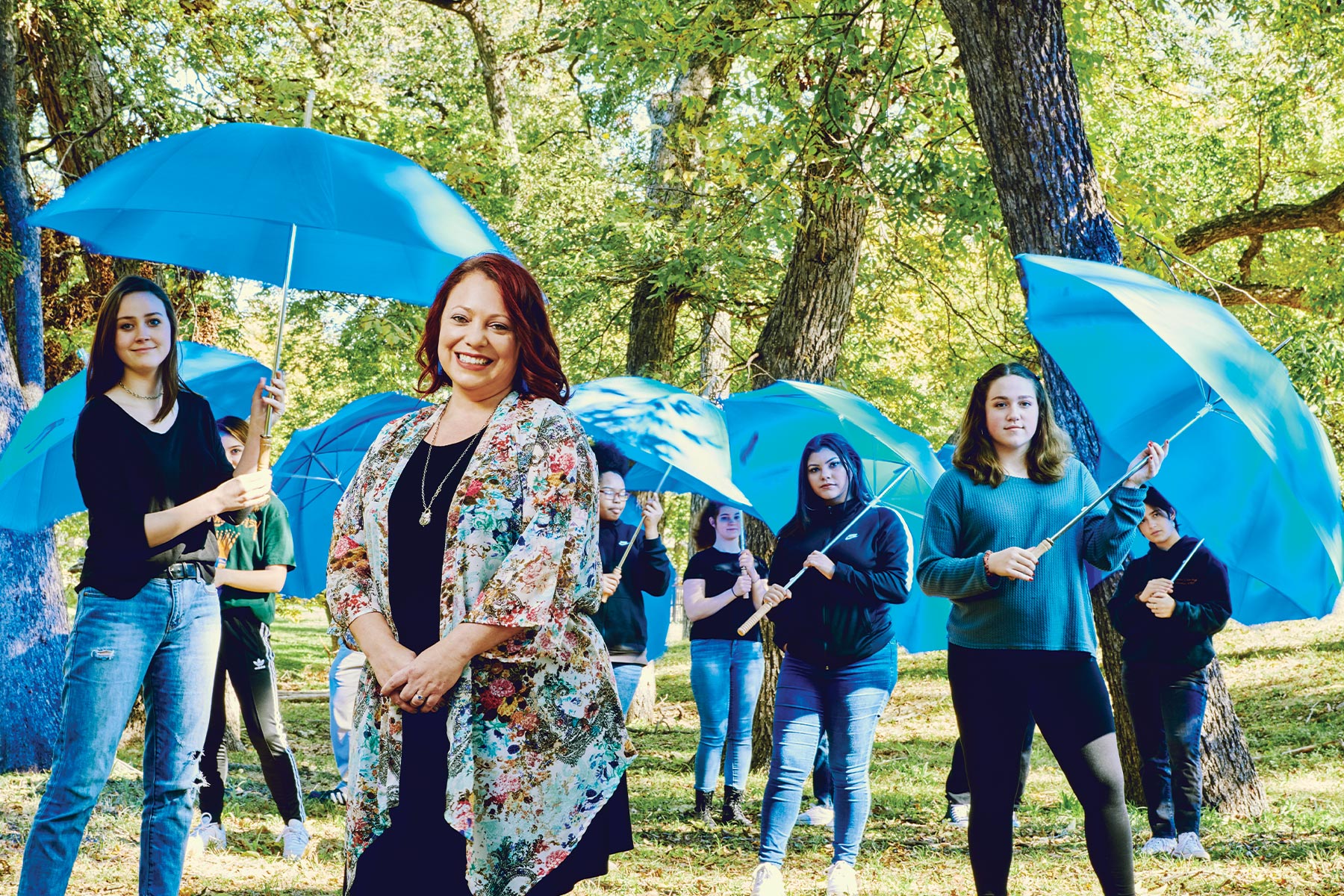Last March, 11 Dallas high schoolers sat in a hotel room in McAllen, Texas, to decompress after a long day. Throughout the previous week, they had traveled along the border as part of a research project organized by Cry Havoc Theater Company, a youth troupe founded by Mara Richards Bim in 2014. The students learned about the border crisis firsthand by volunteering at a Catholic Charities outreach center, distributing food to families on the bridge over the Rio Grande River, crossing into Mexico to speak with migrants waiting to enter the United States, and interviewing officers with the U.S. Immigration and Customs Enforcement Agency. But that day had been the hardest. Thanks to a contact on the border, Richards Bim was able to set up a meeting at a church with a few dozen young migrants—many of them the same age as the Dallas students—who had been separated from their families and were being held in a detention center.
Needless to say, it was not your typical spring break trip. One of Cry Havoc’s teen actors played cards with a cheerful 17-year-old boy who had been locked up for eight months. Another spoke to a 13-year-old about his dream of making his way to family in Louisiana. One actor recognized a boy from the detention center. He had attended first grade with him in El Salvador. The encounter, he told the room, left him feeling angry and helpless, and as he spoke, he burst into tears. Angie Hogue, a senior at Booker T. Washington High School for the Performing and Visual Arts, says the trip to the border was emotionally taxing. “It was weird being in the Valley, in Texas, the same state I grew up in,” Hogue says, “and there’s this humanitarian crisis happening nine hours from my house.”
After returning to Dallas, Richards Bim and her co-director, Tim Johnson, used the teens’ interviews and reflections to create Crossing the Line, a piece of “devised” or “verbatim” theater, a form of documentary drama that uses oral histories, firsthand accounts, interviews, and memoir to create a theatrical narrative. When it debuted in July, Crossing the Line was unlike anything else happening on local stages—raw, honest, immediate, and relevant. The website Theater Jones called it “necessary theater,” and it won the Dallas-Fort Worth Theater Critics Forum’s awards for outstanding new play and outstanding performance by an ensemble—an ensemble composed entirely of high school kids.
In the few short years since Richards Bim started Cry Havoc, the theater company has produced some of the most consistently exciting work in North Texas. That Cry Havoc is also a youth theater—a troupe of actors who audition from local high schools—isn’t just an anomaly, it is integral to the formula of their success. Richards Bim started the company after returning to Dallas from New York, where she had worked for years as a fundraiser for theaters, as well as teaching theater in a public high school and leading curriculum development for the New Victory Theater, an acclaimed youth theater. Back in Dallas, she saw that the adult theater scene had matured in her absence, but she didn’t see the same evolution in theater for young people. “There weren’t a lot of options for young people to be onstage that were not pay to play,” she says.
Richards Bim began toying with an idea for a kind of youth theater that Dallas lacked. It wouldn’t charge for participation, so it could draw teenagers from different backgrounds and parts of the city. It wouldn’t censor the youth voice or present “after-school special” productions, pieces that “water down topics in ways adults think children can process,” she says. When she casually mentioned the idea to a lawyer friend over lunch, he volunteered to draw up the nonprofit paperwork. Dallas’ Office of Cultural Affairs had recently launched a small grant program, and Richards Bim managed to secure a little funding. She figured she could produce one performance and see how it went.
Cry Havoc’s first play was its most conventional—a contemporary adaptation of S.E. Hinton’s novel The Outsiders—but even that production stood out for the way it relied on its student participants to update the language and story. During its run, critics lauded both the production and the diverse audiences it attracted, a byproduct of casting young actors from all corners of the city. The Outsiders made enough money to allow Richards Bim to stage a second production, Shut Up and Listen! But it wasn’t until July 2016, after five police officers were killed in downtown Dallas, that Cry Havoc really began to find its voice.
Trinity Gordon, a recent Skyline High School graduate, remembers coming to rehearsal after the shootings. “One of the actors, her sister was downtown when it happened,” Gordon says. “I think seeing that, and all of our reactions, this was something that affected us more than adults would have thought. That kind of showed Mara that these are things that we have to deal with as youth.”
Richards Bim suggested the students talk to the people who were affected by the shooting—police officers, families of the slain, witnesses who marched that day—to try to process their complex and sometimes contradictory emotions. The result, Shots Fired, debuted in January 2017 to rave reviews.
“I myself couldn’t get access to these people. I think it is because we’re a teen company. People say yes because they are like, ‘Kids, sure, what harm could they do?’ ”
Mara Richards Bim
Richards Bim says Shots Fired was modeled largely on The Laramie Project, a 2000 play that drew on hundreds of interviews conducted with the residents in a town in Wyoming where a gay student named Matthew Shepard was murdered in 1998. She says she was also influenced by her time at New York University’s Tisch School of the Arts, working with Brazilian theater practitioner and political activist Augusto Boal, who founded the Theatre of the Oppressed. “I was always trying to figure out how I would create that kind of theater, theater for social change,” Richards Bim says. “Like, what does that look like and how do we do it in an American model?”
With Shots Fired, Richards Bim discovered that one way to translate Boal’s almost therapeutic dramatic approach to an American model was to work with teenagers. Cry Havoc followed Shots Fired with Babel, a piece about gun violence and the Sandy Hook massacre. To create it, the teens traveled to Connecticut and Washington, D.C., to interview parents of Sandy Hook victims, activists involved in the gun control debate, politicians like Sen. John Cornyn, and attendees at the NRA convention in Dallas. “I myself couldn’t get access to these people,” Richards Bim says. “I think it is because we’re a teen company. People say yes because they are like, ‘Kids, sure, what harm could they do?’ ”
What Cry Havoc’s teens have managed to do is create theater that tackles complex issues like gun control, sex education, our relationship with food, and the border crisis with empathy and nuance. This month, Cry Havoc’s 20/20 Vision will deal with digital technology and social media, and in July, the company will produce a play about the environmental crisis. Also this month, Cry Havoc’s troupe has been invited to headline a one-day symposium in Philadelphia about the role of youth in shaping arts and culture. In March, they will present a reading of Crossing the Line and lead a master class at SXSW EDU.
Now Richards Bim finds herself trying to expand the reach of one of Dallas’ most exciting theater groups while navigating teenagers’ busy schedules. She says they have to rely on holiday breaks to research and rehearse productions, and though she has finally moved the production offices out of her dining room and into a small office at Common Desk in Deep Ellum, fundraising for a company that can perform only when kids are out of school can be a challenge. She sees potential in spinoff projects, like monthly open mic performances or podcasts or web series produced from the hundreds of hours of audio and video they have collected.
But those are minor challenges considering what Richards Bim has already accomplished. She built a theater company by trusting teenagers, proving that there is art to be made by listening to voices that are often ignored or muted. It’s a strategy that some of Dallas’ grown-up arts groups would do well to adopt.







